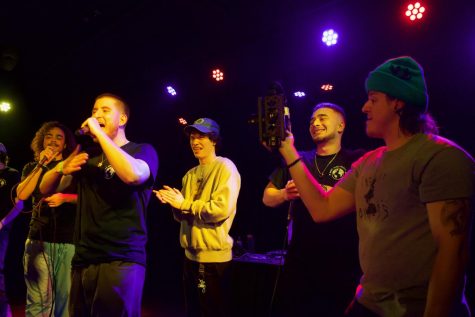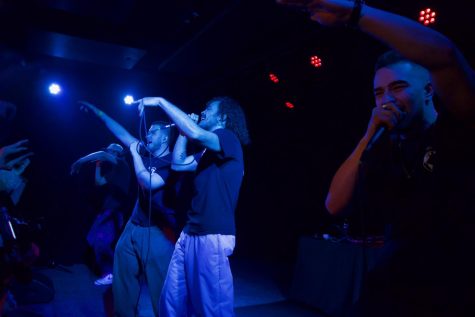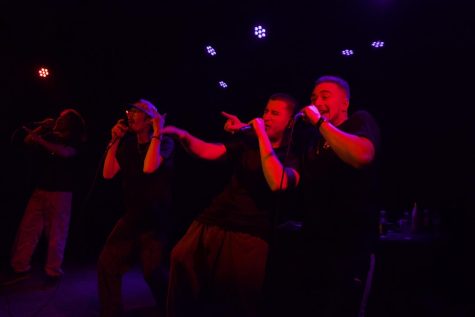Putting the ‘ECO’ in East Coast Oracles
How the Amherst art collective is establishing an ecosystem of its own within the Pioneer Valley community
May 2, 2023
When entering the home base of The East Coast Oracles, widely known as “The ECOsystem,” I am welcomed with the very elements conducive with any environment seen in the wild. A group of interrelated beings (college-aged guys) sprinkled amongst a sea of lush nature (an assortment of art pieces, large speakers and paraphernalia) all bonded together under one uniting entity (their love for all things music).
Beyond what is visible within the Oracles’ “ECOsystem” suggests a greater internal meaning to the word, resembling a magnetic mission and identity beyond what could be tethered to any singular area or genre.
The Amherst-based art collective is a group of ten (and counting) 19-to-22-year-old artists, working together to create and promote inclusive endeavors of creative expression. With a core focus in establishing a hip-hop identity amidst the ever-growing Pioneer Valley music scene, the Oracles continue to branch off into the infinite subsets of art so often interconnected with music.
“When we call ourselves an art collective, we are definitely first and foremost a rap group,” Oracles member Sam Cove, “Sound-Wave Shmu,” said. “For us, it’s just about encompassing everything that art is to us, whether that be fashion, music, photography … anything, and allowing it to be as influential as we think it is, to the community as well.”
With members like Adam Alexander, “Triple AAA Films,”who develops videography and music videos for the collective and other local artists, to Joon Eom and Liam Stapleton, “DJ Tech Node,” both producing the rap group’s beats, the Oracles are undoubtedly a hodgepodge of individuals. Nevertheless, the collective embodies a certain cohesion as if it were your run of the mill boyband without the forced authenticity.
“Our main goal for the collective is creating a community where we can have all kinds of artists involved in building something, so anyone can have the opportunity to post up at our events or home [The ECOSystem] and be a part of something they can benefit from themselves,” Oracles member Gabriel Grimes, “G. Grhymes,” said.
This “something” ultimately surrounds the Oracles’ most popularly known attraction: its work as a rap group. The collective’s inception began within the humble halls of UMass’ Baker Residential Hall.
Grimes and Cove were paired as roommates in the fall of 2021, quickly connecting over their shared passion for music, specifically rap. Soon, Cove introduced Grimes to his high school friend, Mosiayah Harvey Ahmai, “The Bush-Wzrd,” with whom Grimes clicked instantaneously over this same passion. By December of the same year, the Oracles was born.
“A group of us were sitting in the car at our favorite smoke spot in the center of Amherst on Grove Street, hanging out, and we just threw a ton of different names and words out there. We eventually thought of ‘East Coast Oracles’ and immediately knew that is what we were going to be called. The acronym for that is E-C-O which is fitting, so we ran with that. The name of our first tape even ended up being “Eco Friendly,” Ahmai said.

The founding trio later met the group’s remaining members in Eom, Stapleton, Alexander, Nehemiah Caradwyn, Bret Silverman, Cru Frobel and Josh “Tree” Sathyaraj through similarly organic fashions. From all corners of the campus community, the Oracles is rooted in flourishing, symbiotic relationships consistent throughout the earthy aura present in the collective.
“I think I slid up jokingly on an Instagram story and was like, ‘Hey, Yo, let me in,’” Caradwyn said. “And they said something like, ‘Yeah, you know, you’re in this if you want.’ And that was that.”
Given hip-hop’s long standing ties to a diverse myriad of artistic and cultural influences, the constantly evolving and additive nature of the Oracles is consistent with the collective’s mission of promoting any kind of artist — all within the lens of promoting the historically underrepresented Pioneer Valley rap scene.
The only non-negotiable to be deemed worthy of inclusion into the collective is a willingness to adopt a sense of inspired fluidity, jestingly known as the “Oracle-way.”
“We’re down to collaborate with anyone, but to be an Oracle, you got to have the vision, the right perspective and the drive to create,” Ahmai said. “Really, if you’re able to hang out with us and we like the art that you make, truly whatever that may be, we want to incorporate you with us.”
The open versatility within the Oracles kinship is mirrored within the group sound. While hip-hop influences are most glaringly detectable in the Oracles’ syncopated verses and technologically enhanced instrumentation, the group attributes a blend of genres and communities as intrinsic towards finding their own identity among those already established in the heavily indie and rock local music scene.
Members such as Ahmai cited their introductions to rap occurring in the later years of adolescence, making for the various stylings each member was raised on as a common inclination towards experimentation.
Drawing from the stylings of the reggae, jazz, EDM and R&B of its members’ youth, the Oracles aims to adapt this sonic palate, with a fusion of the late 1980s to early 1990s “East Coast Boom Bap” — an influence resonate in the collective’s very name.
“It definitely sounds jumbled around, but I feel if you’ve listened to our music, it makes sense. You can see that our influences are scattered around, but we groove and modernize them all together … and it works,” Stapleton said.
As my own interactions persisted with the Oracles, so did my understanding for each member’s necessity within the collective outside of their respective artistic palates and talents. Through interviewing and listening to the rap group’s core members in Cove, Grimes, Caradwyn, Stapleton and Ahmai, each conveyed their own distinct personality. They were unafraid to speak on varying musical inspirations, random thoughts and experiences shared between one another.
Certain members act at times as the managerial voice of reason amongst the controlled chaos attached with being a 10-person, unmanaged and completely independent group, while others guide the facilitation of fun necessary to evoke the collective’s ever-circulating, ever-entertaining creative juices.
Whether it be Cove, Grimes or Stapleton discussing a difference of opinion over a specific track, or just minutes unleashing in an uproar of shared laughter and chatter after Caradwyn or Ahmai comedically pokes fun at another’s response, each Oracle oozes passion for not just the inherent work they create, but for one another.
“’I’m about to make the tape from outer space baby! The first tape from outer space, you never heard this before! I’m a quantum physicist, making the tape from outer space,” Ahmai laughingly chanted. “I went to UMass for physics to become a quantum physicist, but since high school, [Cove] knows this, I’ve been saying I want to make the first rap album from outer space is the end goal … it is basically the scope I want ECO to have.”
Caradwyn chimed in with his goal of being the first person to create an album from the depths of the ocean.
“Live from the Trench, the Mariana Trench!” Caradwyn and Ahmai exclaimed.
“All of our meetings are supposed to be one hour, but they always end up being like three. We all love to talk, we love spending time with one another,” Stapleton said.
The “Oracle-way” isn’t merely a specific sound or mindset the collective reverberates; it is a lighthearted way of life each members harmoniously believes in.

With the current norm of the Amherst music scene being that of awkward swaying and pervasive moshing in sweaty basements to the tune of guitar-rooted, head-banging bands, ECO strives to create distinctive sounds and experiences of its own kind.
The art collective has launched a public outreach campaign of sorts, finding ways to get its music and initiative out to anyone within ears’ distance. Outside of daily updates posted to its Instagram (which is essentially entirely manned by Grimes, the acting one-man advertiser, executive and artist of the collective) the group makes it routine to set up shop in Amherst’s most popular areas.
Whether that is hosting “Rave Nights” at Garcia’s under Stapleton’s own DJ collective, “Usually Underground,” to members playing tracks outside high-foot traffic zones such as Blarney Blowout at the Townhouses and Antonio’s Pizza for late-night weekend bar crawlers, the collective has made it a point to take up space in the community.
“As it gets warmer, we are just doing pop-ups all over the place so we can get our music, and more so name out there. It’s fun to play music, and see people brightened up by the good vibes,” Grimes said. “When I’m on campus, I’m not playing any hard, ‘BOOM-BOOM-BOOM’ stuff, just the other day we played PinkPanthress’ ‘Boy’s a liar’ like seven times to open our set and people loved it.”
Beyond the music they play and art they create, what makes the Oracles so distinctive within Amherst’s music scene is this: it is evident the groups is trying its very best, while having a whole lot of fun.
ECO is still actively trying to gain traction within the greater industry, while trying to create and release music; while some members are college students; and while others have dropped out entirely to wholeheartedly try and make this dream of “making it” a reality.
But what makes the Oracles intrinsically imperfect has made a lasting impression of likeability within the Pioneer Valley community.
Lincoln Allen, the managing director of downtown Amherst music venue, The Drake, is one of those impressed people. Ahead of the Oracles’ most recent gig at The Drake, called “Hip-Hop Night at the Drake,” on March 30, Allen was approached by Grimes on behalf of the Oracles, seeking to book the establishment after finding availability in The Drake’s schedule.
“It takes a while sometimes to get a date on the calendar that works for both the venue and the artist. It just so happened we had that Thursday night open, Gabe [Grimes] popped in and set everything up,” Allen said. “It was last-minute on the calendar, but we had a large turnout and that’s all kudos to them for promoting it.”
After clinching the date, the Oracles began what the collective does best: create. Despite scrambling to formulate an official setlist to send in for approval while finding ways to entice the public to attend, ECO was victorious.
Alongside Western Massachusetts rap trailblazer DJ Lucas and newcomer rapper Hooper James, the Oracles performed its own set, a 13-track compilation of old favorites and new works to a virtually sold-out crowd.
With 150 presale tickets sold, on top of 135 covers claimed on the night of the show, the Oracles’ tenacity had finally been rewarded.
“It was really refreshing to do a full hip-hop card that we put on ourselves, and see so many people still come out,” Grimes said.
“The turnout is just proof that we do know what the people want,” Caradwyn said.
Sora Green, a junior psychology major and Carolyn Biggart, a senior psychology and Spanish double-major, both (like the Oracles) bonded together over a shared common interest and space. Now, the two friends attend the Oracles’ shows as a result of the all-reaching, intertwined nature synonymous with ECO.
“I went to high school with two of the members of the East Coast Oracles and I’ve been following them pretty heavily since the beginning,” Green said.
“I met [Green] through our psychology classes, and I actually met the Oracles’ [Cove] through work at the UMass Store, so it’s just a really weird, yet awesome small world moment. That’s why I wanted to come out to The Drake and support them,” Biggart said.
The Oracles’ Cove, Grimes, Ahmai, Caradwyn and Stapleton graced the stage, neither one outshined the other as they traded verses and locations atop the stage. Each member was cognizant of wanting everyone to get their moment to bask in the fluorescent, all-encompassing spotlight.
Expressively dancing and rapping to every beat thumped, the present Oracles’ members performed to one another just as much as they played into the ensuing audience’s delight. Carefree chuckles and grins infested every facial expression and bodily movement present on stage.
“I had a lot of fun on stage, and I was really in my zone because of it, all of us were. I’m performing with my boys, I’m making the music that I love and I’m doing what I want to do. That performance has opened a lot of doors for us and we met a lot of cool people that appreciate us just because we are being ourselves up there,” Cove said.
I could have been bearing witness to a leisurely garage rehearsal, if it weren’t for the dutiful adoring concertgoers, mimicking the joyous contagion spread by the Oracles.
“They [the members of the Oracles] are just so energetic, and very visibly happy to be here performing. It is a feel-good show to see,” Green said.
Even though members such as Stapleton, Alexander and Silverman didn’t have clearly visible roles in the performance, the other members of the rap group made it a point to validate their fundamental roles, ushering them to the front of the stage for applause.
This air of sound confidence in what and who they stand for as a collective has allowed the Oracles to develop the makings of a following and reputation contrasting a once overarching, stagnant apprehension to adopt hip-hop as a worthy subset of the Amherst music scene.
“The challenge of being in a dominantly indie music scene and culture has really helped us as a group. It makes us hungry and makes us want it more because we’ve seen rejection. We’ve seen the challenges of booking shows because some people don’t think this is a hip-hop area,” Cove said. “Doing a lot of this work ourselves and putting on our own shows is how hip hop started; just by people throwing their own parties and making it happen. The ‘do it yourself’ aspect has forced us to nail down our uniqueness and dynamic as a group.”
Now, ECO looks ahead to its most important project yet: its first cohesive album as a group. Meeting at least five times each week, the collective’s producers, lyricists and rappers have, and continue to conference around the clock.
“More recently, we’ve been trying to do everything for the album together. But also, our inspirations can come at any time, like me, I always am writing while I’m driving. When one of us gets an outside inspiration, we just start working from wherever an idea takes us,” Grimes said.

This kinetic deflection of ideas and energy amongst the Oracles is a practice so ingrained in their way of being that it is transferable to all who cross the members’ paths, even through a computer screen.
“We have a friend we met online named Celestial Cerebrum and he is always making beats. We ended up picking out one of the like 100 that he sent to us, and I had this idea for the first verse as soon as I heard it. Then once [Cove] and [Ahmai] heard it they were like, ‘I see this Honeybee idea, I see what y’all are cooking up!’” Caradwyn said.
“Honeybee,” the lead single of the collective’s upcoming album, “Rappers Kill Kids,” is one of 13 tracks set to be released on May 12. Though the specific work is an ode to the proponents of love, revolution and authenticity, the group strives to remain uncontained to any one idea or essence.
“Each verse and sound have a mini kind of story encapsulated within it, the interpretation of whatever core idea a song is about is different for each of us,” Ahmai said. “The album is still cohesive though, tracks like ‘Honeybee’ may come across as a bit darker and grittier than the stuff we normally do, but we are still speaking on the same topics we do already.”
“Rappers Kills Kids” is a product made entirely by Oracles outside of production on four songs from Celestial Cerebrum and J. Edvinn. Ahmai served as the central artist responsible for producing, mixing and mastering the remainder of the project while the remaining collective members helped bring the project to life.
Despite their creative strength, certain difficulties arose that the collective are actively trying to navigate.
From members like Grimes who have exhausted much of their financial resources and time to serving within many capacities of both the front and back end of the initiative, to those like Cove, who already are eager to create in new mediums and new ways, the Oracles’ infinite potential creates uncertainty on how to best equip the group for what is come.
“The biggest challenge will be tying our energies together in collective way so we can maximize the momentum we have going right now,” Grimes said.
But just like any other ecosystem, ECO is an ever-changing and evolving entity that is equipped with the unity of one another and the resources of a self-made community to prosper from whatever storm rolls ahead.
“Being a collective, there are so many ideas and people to bounce literally anything off of. I think especially after ‘Rappers Kill Kids’ having more people involved now than ever before, we are better as artists and friends for whatever may be next,” Silverman said
“Rappers Kill Kids,” upon its drop, in addition to the East Coast Oracles’ preexisting music, are available on Spotify and Apple Music.
To stay up to date with the Oracles in regard to upcoming live events and opportunities, including a “Rappers Kill Kids” release party at The ECOSystem on May 12, follow The East Coast Oracles on Instagram.
Shanti Furtado can be reached at [email protected]. Follow her on Twitter @shantifurtado.
